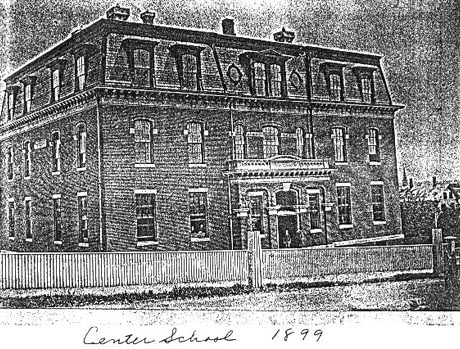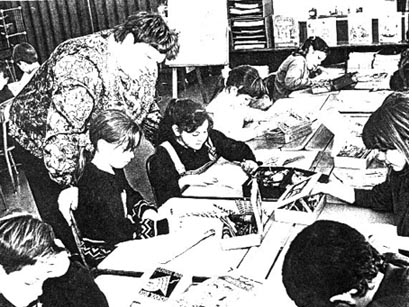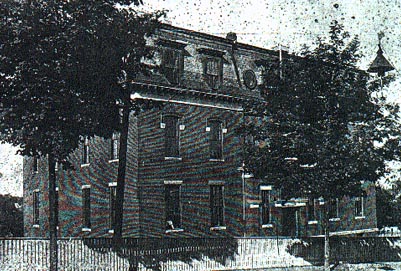
by Andra Calisto
The first Centre School was built in 1765. It was a brick building with ten and a half rooms. [Source: Amos Merrill, A History of the Schools of Peabody During the Nineteenth Century, p. 4. Manuscript of the Peabody Historical Society.]
The school had popular teachers, such as Master Storrs. The first male teacher at the Centre School, he was a tall man and his weight was over two hundred pounds. He was a good scholar and dressed fashionably. Master Storrs, who was a bachelor, wore a blue coat with brass buttons and breeches. He also wore long, white-topped boots and he liked to chew tobacco. He also had great penmanship. [Source: South Danvers Wizard, 2/22/1860, p. 2/2].
Another well-known teacher was Master Benjamin Gile. A pupil of his described him as "a giant, corpulent old man". He wore a broad-rimmed hat and a dark-colored, broad-skirted coat. Part of his pants came up to his knees and had a huge buckle. His shoes and boots were made of coarse cowhide. Benjamin Gile died April 16, 1834. He was 70 years old. On his gravestone at Monumental Cemetery, it reads, "I taught little children to read." (John Wells, The Peabody Story, pg. 255)
A pupil of the first school in the Center district, John Webster, related memories of his school days at the town's Centennial Celebration in 1852. He said Gile was "a quaint, eccentric, corpulent old gentleman" who superintended over a school where "a little box cast-iron stove stands near the centre of the room" that was crammed with wood on cold, winter mornings. The seats were separated in different parts of the room for girls and boys.
"The master stands at his desk and the school is opened with the salutation, - Boys, I am 10,000 years old. You see I've got my old coat on to-day, and I always tell you, when you see that, you must look out. I hope I shall not have to kill any of you to-day. …The snow drifts are too high for the girls to be out, and the boys are permitted to cluster round the stove, the usual routine of morning exercise omitted, and the morning hours are devoted to reading the Bible, such of the scholars reading a verse each, alternately, that choose to do so, while others, with the Bible at hand, are playing Pins - head to points - and other praticising the instructive lesson of Spin Sparrow - but alas! For the lad who has not the right verse in succession to read if called to do so by our master; the heavy cow-hid whip rings over the back of the unfortunate one, and a general whispering inquiry, from one to the other, is - Where is the place?
"In the course of instruction pursued by our teacher, it was a matter of no trifling importance that every one in the class should exactly toe the line or crack in the floor. Failing to do so, as was sometimes the case, it was no unheard of practice of the master to apply his huge shoulders, vigorously, to the one standing at the head, and a good proportion of the whole class were tumbled in a heap on the floor; as you have seen, a skillful player at ten pins, by striking the head one, score the other nine.
"In addition to the distinctive names which parents usually give to their children, our teacher had quite a number of pupils that he distinguished by favorite, additional titles of his own. On girl, now the wife of one of your wealthy citizens, was usually addressed as the girl who came out of the clouds; one boy was called Wisdom, one Bonaparte, another Old Buck, &c.
"Nor were the modes of punishment for school offences any less original, ingenious and impressive. Among these, were standing on the platform with a piece of wood partially split, which was placed across the nose of the offender, the effect of which was something like placing the nose in a vise. This was called wearing the spectacles, after wearing which an hour a boy could, undoubtedly, see to study better.
"Holding a heavy stick of wood in the hand, with the arm extended perpendicularly, was another method of punishment and others, still more original, were practised, which I will not take up your time in relating.
"The course of instruction was limited to Reading, Spelling, Writing and Arithmetic, in which latter branch our teacher was wonderfully skilled. Near the close of his administration, which continued several years, the first germ of progress began to be developed, a portion of the parents thinking it necessary that their children should be taught English grammar. Murray's Grammar was accordingly introduced into the school as a reading book, and this was the method by which we were initiated into this mysterious science, and it may suffice to say - our knowledge of this branch was very soon fully up to the standard of perfection to which our teacher himself had arrived. The schoolmaster of the present applies the screw to develop the boy's brains, he of the past applied the cow-hide to develop marks on our backs. The teacher of today is inquisitive, he requires a Why or a Wherefore; the former one never gave offence to his pupils in this way.
"Well I do remember the fear that filled my youthful heart, at the oft-repeated warning given us to beware and dread the last day, - not of the duration of the world, - but the last day of school term. So impressed as I with the fear of what the cow-hide was to do, that I prevailed on my parents to allow me to be absent on this eventful day, and great was my astonishment, when meeting my school companions after the close, to hear how the day had been passed. The exercises were commenced with a spelling match; two of the elder lads choosing, alternately, the most skilled in this important branch, and down till rows were formed, facing each other for the battle, the whole length of the room. The crooked and uncouth words of the Dictionary were selected for the contest, and the side, which had recorded against it the most errors, was pronounced the vanquished, and the victors were allows to hurra, scream, shout, hiss and stamp their feet and clap their hands, to their heart's content.
"After this, all the jack-knives, tops, pop guns, spin sparrows and other boyish valuables, which had been seized for their several offences during the year, were taken from the depot, the master's desk, thrown on the floor, and scrambled for by all the boys.
"Mr. President, I have detained you longer than I intended. The imperfect sketch which I have given is no fancy, no embellished picture of our school, as several I see present, who were fellow-pupils at the time, can bear me witness.
"Sir, a distinguished writer has said, "to interpret the present thoroughly, we must understand and unfold the past." The historian, the antiquary are searching the world over, among musty parchments and fragmentary documents, for records of deeds of the past. Should not the school and the teacher of other days be brought up to the light, that our youth may more highly estimate the advantages of the present? Great men are giving the work of their heads and the work of their hands to popular education. Our towns, even those of limited, pecuniary means, are taxing themselves with no grudging or stinted measure, for this object.
"A history of the public schools of New England, their origin, their progress, their present condition, it seems to me, would be no unwelcome volume.
"What the record will be of the schools of Danvers at a second centennial celebration, is not for us to inquire. Only let your motto continue to be, "Excelsior, your aim perfection."
"I close, sir, by proposing the following sentiment (to):
The pupils of the Public Schools of Danvers - Let them profit by a comparison of the present with the past, and make the best use of their increased advantages of instruction, always venerating those whose highest ambition it was, to "teach the little children to read." [Source: Account of the Cenetennial Celebration in Danvers, June 16, 1852 Together with the Proceedings of the Town in Relation to The Donation of George Peabody, Esq. Of London, Printed by Order of the Town, 1852, pages 173-176.]
Thomas Smart - Teacher in 1775. (Appendix 3)
Describe the third Center School.
Was the fire set? Where did the students go to school after the fire?
By Danielle Patch
The third Centre School had a very interesting history. The school, which was located on Franklin Street, was a three-story brick building with large rooms. It smelled oily because the wooden floors were always oiled. It's said that the reason the school burned down so fast is because the janitors oiled the floors every day.
An arsonist set the fire in April 1952. Several anonymous sources told us that there had been a series of fires at the Centre School at that time. A year before the school completely burned, there was an article in the Peabody Times (April, 1951) reporting that a small fire was extinguished at the school. According to the rumors that circulated in the city, the fire was set by two boys, students at the school - one of whom had connections to a prominent person in Peabody and that was why the story was suppressed.
Julianne McLaughlin, a teacher at the Center School in 1998 who attended the third Centre School as a pupil, recalled that the teachers at the school had been there for a long time. "They remembered everybody in the family. They knew who you were and who you were connected with and what your people did," she said. "After the fire, a lot of the older teachers never came back. They retired. It was like the fire just did it for them and they couldn't come back again after that."
When the school burned, McLaughlin was in the third grade. "I remember that that day we had had Doll Day at the school and I had brought my doll. I left my doll there and the doll burned," she said.
Recalling experiences at the school before it burned, MacLaughlin said, ""I went there for grade 1,2 and 3 and each one had a cloak room. The desks were, of course, bolted to the floor and we learned well. There was a huge tree in the front yard we used to play under all the time. It was tarred and the St. John's kids were right behind us. They were like down from us and we used to yell over the fence. They used to yell back because we didn't like each other. They called us 'publics' and we called the 'catholics'. It was a crazy thing but it was what you did at recess everyday. They didn't like that. So, they changed recess time and then we didn't harass each other all the time."
After the fire, MacLaughlin remembers attending the Farnsworth School, which went on to double sessions for the remainder of the school year. "We were in the basement. We were in the younger grades. We went first and nobody liked us and then they didn't know what to do with us. So, we ended up at the Carroll School, all of us. They had to make room for the entire Center School at the Carroll School. We did have our own teachers and our rooms and we didn't mix much with the Carroll School kids, except at recess times and lunch."
The parents of the children who went to the Center School were worried about where their children would go to school. The Center School PTA and members of the school board met on May 16, 1952. The PTA presented a plan where the first three grades would continue attending Farnsworth School in the morning and the older children were transferred to morning sessions at Peabody High School. That meeting led to the problem that no space was available at the high school, so committeeman (Frank) Wiggin came to the decision that the school board needed an alternative plan. As a result, the parents were polled and had an opportunity to vote on June 3, 1952, for three plans: 1) fourth through eighth grade would attend the Farnsworth School from 12:15 to 4:15 p.m.; 2) fourth through eighth grade would be transported to other schools so they may attend during regular school hours; and, 3) fourth through eighth grade students transported and paced according to their grades in the same rooms as the Keefe School pupils. On July 25, 1963, the alternative plan was approved that sent grades 1,2 and 3 to the Farnsworth School. Grade 4,5 and 6 went to the Thomas Carroll School and grades 7 and 8 went to the Wallis School during regular hours.
When the Center School students returned to their new home, McLaughlin remembers, "When we walked, we couldn't walk in the middle of the hall because we had to leave it shiny and clean. We had to walk along the wall because people were coming in to visit all the time and the school always had to look lovely. We couldn't throw things away, only once a day, because we had to keep the wastebaskets looking clean and not full. There were a lot of things that we did to keep the building looking beautiful. I remember we all ate at once in the cafeteria, all eight grades. And we all went outside to play at the same time too."
An anonymous senior citizen submitted the following members of the Center School:
I went to the brick Center School before it burned. I went from the 5th through the 8th grade. Ida B. Farnum, a grey-haired Quaker lady who always wore a long, navy blue serge skirt, white cotton blouse and black sating bow tie, had a stuffed bird collection in a glass-doored cabinet. Everyone said, 'She was very strict but you knew you subjects when you left her room.' Bas boys got the rattan in the dressing room if they misbehaved or had yellowed fingers from smoking.
Miss Sullivan (pretty and a sister who taught in the High School) taught the 6th grade. In 7th grade, we had four teachers: Arthur Flanagan, everyone liked; Esther Billings, Miss Maloney and Mrs. Bertha Packard. In 8th grade: Mr. Stephen Stickney part of the year, well liked; Mr. Flanagn, Esther Billings and Mrs. Packard.…Frank Lynch was a nice man, custodian of the Center School at the time. We had a pleasant custodian at Center School in the 1920's, Mr. Kerwin.
Ruth Keane Sullivan recalled, "The old Center School will always hold a special place in my memory. Although I did not attend the school, I lived across the street (Franklin) from the school. I especially remember seeing Arthur Flanagan, the school principal, devoting himself to his school playing basketball with the kids, and never left to go home until all was quiet and peaceful. He was a special man. Later, I felt honored to be a teacher at the new Center School, and had the opportunity to work with many teachers who had worked with Mr. Flanagan."
Sullivan also fondly remembers Marion Dumas, a Center School teacher, who was helpful when Sullivan began her 20-year teaching career at the Center.
Memories of the Center School were also submitted to the Peabody School History Project by Katelin D'Amours. (Appendix 4)

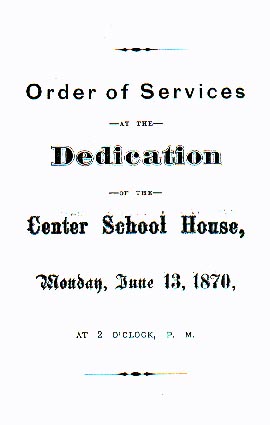
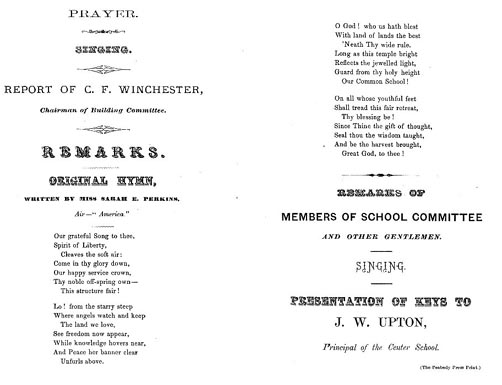
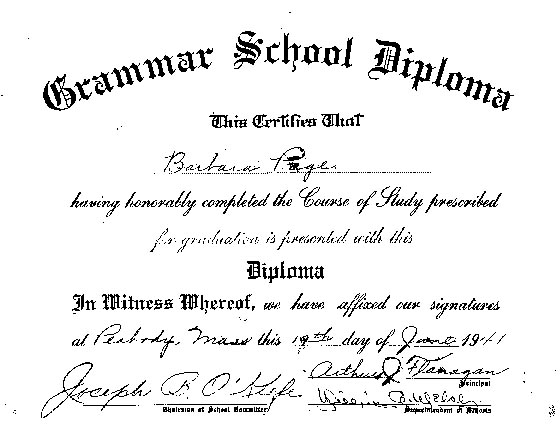
The namesake of the Center School gymnasium, Philip Dorgan was a 1936 graduate of the Center School and a 1940 graduate of Peabody High School. He was employed for a brief period at A.C. Lawrence Leather Co. and was attending Northeastern University when he enlisted in the U.S. Marines. He was 21 years old when he was killed on November 2, 1944 in an airplane crash while on transport duty in the Hawaiian theater during World War II.
He entered the service in July, 1942 and received his pre-flight training at Chapel Hill, N.C. and his primary flight course at Peru, Indiana. He received his commission as a 2nd Lt. in the Marine Corps in June 1943 and received his wings at Pensacola, Fla. He was promoted to the rank of 1st Lieutenant a year before his death.
Dorgan served at Sanford, Fla., Cherry Point, N.C., San Diego and El Centro, Cal. and went overseas in the late summer of 1944. He was born on June 30, 1923, the son of Marion and Timothy Dorgan of Buttonwood Lane.
A former student of the Center School provided information anonymously to the Peabody School History Project about Lt. Dorgan. "Philip Dorgan was 'Ma" Dorgan's son. She ran the A.C. Lawrence cafeteria and he is probably related to Rev. Dorgan, the priest in Danvers. Philip Dorgan was related to Martha Quinlan of South Peabody. "
Lt. Philip Dorgan Memorial Mass (Appendix 5)
The fourth and current Center School was built following the fire and involved taking land from descendants of some of the earliest settlers in the area of Forest Street. What role did Daniel Putnam King play in the establishment of the Massachusetts Department of Education?
By Janelle Suckley
The land and house where the Center School now sits belonged to Michael Shafflin in 1659. He came from New Scrum (Salisbury) Wiltshire, England. He sailed from Southampton on the ship James in 1659 and arrived in this area that same year. He was a tailor and was appointed a town constable in 1645.
Following his death in 1685, the property was left to his wife, Alice Shafflin. In The Peabody Story by John Wells, he reports that during the witchcraft delusion of 1692, the Shafflin's daughter, Alice, made accusation against others. However, he reports that "a timely whipping brought her to her senses before she did any harm."
In 1714, following Mrs. Shafflin's death, the property was left to her daughter, Elizabeth, the wife of Israel Shaw, and Alice, the wife of Thomas Nelson. The estate was divided in 1715 when the house and lot were related to Elizabeth. The old Shafflin house was taken down before 1723 when they sold the land to Colonel Daniel Epes, son of a well-known schoolmaster. The Shafflin property was later owned by the King family.
One of the members of the King family played an important role in furthering education in the state. Daniel Putnam King was born in Danvers, Massachusetts on January 8,1801 in the house that still stands at 237 Lowell Street. In 1823, he graduated from Phillips Academy (Andover, Mass.) and went on to Harvard, being Marshall of his class.
After graduation be began the study of law, but the agricultural life held an attraction for him. King continued his favorite studies of and English literature. He married Sarah P. Flint in 1824. They had seven children.
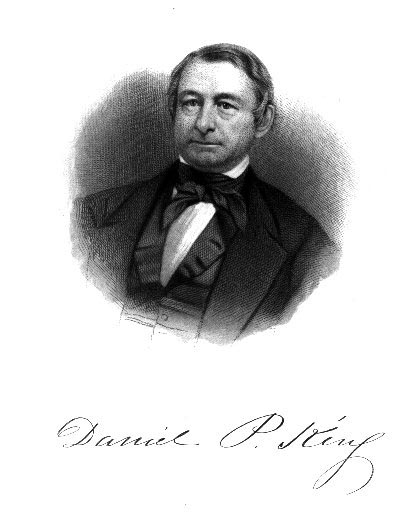
He entered public life in town government and later as a member in the Massachusetts House of Representatives in 1836. While there, he "rendered a great service to the cause of education on January 14, 1837, by introducing and carrying into effect an order instructing the Committee of Education to consider the expediency of providing by law for the better education of teachers to the public schools. This movement followed up and reinforced, at the same session by James G. Carton, a member from Lancaster, led to the establishment of the Board of Education and of the several Normal Schools in the Commonwealth."
The deepest imprint left by his career in the state Legislature relates to agriculture. He brought forward a proposition to establish a college of agriculture at Harvard College.
In a memorial compiled by Charles Upham for the Peabody Essex Society, it reports that a majority of the whole vote was required in Massachusetts for an election to any political office. It became a handicap of the country, our state and our town.
At the state election in 1842, many towns failed to elect representatives to the State Senate, only 24 out of 40 seats were filled and only three out of the ten members of Congress were selected. A third party had come into the field and has become strong enough to hold the balance of power. Daniel King was elected to the 28th Congress in 1843 with a one vote majority. He held his seat ever after by secure majorities.
On July 25, 1850, a few days after he came home, he died in his home in West Peabody opposite Crystal Lake.
What are the unique programs and features of the Center School?
In March, 1998, three new items of historical note were presented to the school in honor of the Peabody School History Project. Ms. Jane Pattison, a Center School teacher, is the daughter of two former Center School teachers: Sarah H. Horgan and Arthur Flanagan (Appendix 6), who later became principal at the Centre and Thomas Carroll schools.
On behalf of her family, Pattison presented the school with three framed photographs of the 1938 Center School Drum and Bugle Corps and Baton Squad, as well as a picture of 1947 school basketball team, of which Flanagan was the coach.
Principal Helene Skerry has two items that belonged to previous principals at the school that she has carefully stored in her office: an old-fashioned pen and ink set that belonged to former principal Timothy Roche and a bible that belonged to former principal Jefferson K. Cole. An inscription on the inside cover of the bible reads: "Center School, Peabody, Mass. June 25, 1914 - Left for use in the school by Jefferson K. Cole, who was principal from October 25, 1880 to this date, June 25, 1914. " Cole died on February 15, 1919.
The Center School library is named in honor of Elizabeth "Betty" J. Minott, a long-time teacher at the school. A picture of Minott is on display. "She passed away while waiting for a transplant," explained Principal Helene Skerry. "This room is dedicated to her because she loved reading. She taught here for many years and she was a book lover. This room was then taken as a special project by all of the staff, teachers and parents. Five percent of all the school's fundraisers goes towards restocking shelves in the library."
A plaque is mounted in Room 3 at the school that reads, "To Karen McCafferty - In grateful recognition of exceptional service to the Peabody Education Council, June 1990." Ms. McCafferty still serves on the executive board of the Peabody Education Council, a business support group that raises funds for innovative classroom projects.
On the surface of school's play yard a large map of the United States was painted by the "Telephone Pioneers", retirees of the Nynex Company. The Pioneers volunteered their time and paint to draw the map. Sand boxes in the play yard were donated by the Center School PTO.
Peabody Times, April 10, 1952
Peabody School Fire Loss $175,000, Boys Questioned
State Enters Probe Believed to be of Incendiary Origin: Two Top Floors Wrecked; Salem and Danvers Send Aid; Lynnfield Kit Also Called; Leaping Flames Seen For Miles
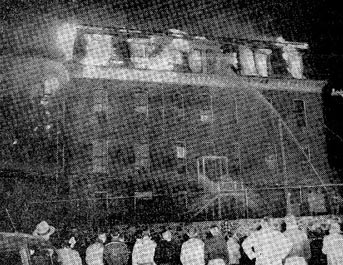
Peabody, April 10 - State and local police and fire officials were this morning conducting an intensive investigation of an incendiary fire that caused $175,000 damage to the two top floors of the 80-year-old brick Center School on Franklin Street late last evening necessitating help from Salem, Danvers and Lynnfield.
Previous Fire
Fire Chief Arthur C. Flynn declared the blaze was definitely on incendiary origin, as was a fire in the same building on April 9, 1951 when $8000 damage was caused to the first floor. Numerous suspects were interviewed at that time, but no charges were made.
Late last night Sgt. Patrick Collins of the police department questioned a teenage youth, and Lt. Joseph Kelleher of the state fire marshall's office at the fire in its early stages, was planning to see the youth today. Other boys also were to be subjected to questioning.
The fire had so great a start that when apparatus arrived from headquarters only a few hundred yards from the school, flames were shooting from the top floor windows on the Franklin Street and School Street corner of the 90-foot-high building.
Entire Floor Was an Inferno
First news of the fire came in a telephone call from a home near the school at 10:30, Box 612 was pulled almost simultaneously from the corner in front of the school. Deputy Chief Timothy B. Roche in charge at the outset ordered a general alarm sounded. This was recorded at 10:33. Help was summoned from Salem and Danvers less than five minutes later. Lynnfield was called later to cover in at headquarters when it appeared that flying embers might cause other fire in the area.
So high was the fire that ordinary hydrant lines were ineffective, and it became necessary to hook up pumps to every hydrant in the vicinity. Later the pressure was increased by combining lines into deck guns and deluge sets placed at vantage points about the building. In this manner the fire was continued to the single building and eventually was brought under control.
It was after midnight before the effects of the 14 big lines pouring tons of water into the building began to show. Shortly afterward it was apparent that the battle was being won.
It was nearly 1 a.m. before the intensity of the fire was cut down so that fireman could work their way into the building and attack the blaze at close range.
The new aerial ladder from Salem which responded with Engine Three from that city proved
Most Effective
as a water tower on the Lowell Street side of the building. The Peabody aerial likewise worked as a tower with the water gun striking at the fire from Franklin Street.
On other sides of the building deluge sets operating with two pump lines pouring into the single nozzle provided an effective force that eventually drowned out the fire.
These also were valuable in preventing the fire from spreading to the St. John's parochial school adjacent to the Center School yard less than 175 feet away and the nearby St. John's Church.
Fire Chief Arthur C. Flynn praised the work of his men and the cooperative help from neighborhood communities which made it possible to check the fire before it had burned much below the top floor starting point.
Supt. of Schools William Welch, Mayor Philip C. O'Donnell and several members of the school committee held an informal meeting in the police station even before the fire was under control, and discussed plans for caring for the 267 pupils house in the 12-room building. There was no school for the pupils for today and tomorrow, and at tonight's regular school committee session plans for
Relocating the Classes
By Monday are expected to be adopted.
Supt. Welch contacted supply houses this morning and found that immediate delivery could be made on desks or other materials necessary to care for the pupils wherever they are transferred.
An inspection of the building early this morning disclosed that the roof and entire top floor were burned away, and that the fire had worked down into the second floor causing heavy damage to three classrooms. The first floor had no fire damage, but suffered heavy water loss raining the new plastering put in only last year after the previous fire.
Police reported that on April 10, a break had occurred at the school, as happened on several occasions before last year's fire. Nothing was stolen, but considerable ransacking was done in the most recent break.
The high location of the building and the spectacular nature of the fire made it visible for miles, and hundreds flocked to the city. Police closed off Franklin and Lowell streets early to keep the crowds away from the apparatus.
Jefferson Cole, a veteran of the Civil War, had the longest stewardship of any other principal in the history of the Center School. He held the position of Principal for 34 years from 1880 to 1914. "Many of the old timers in this city will recall Mr. Cole as being quite a historian and he was eminently proud of the fact that he was present at the surrender of General Lee to General Grant at Appomattox courthouse. From time to time, there were suggestions that the Center School be re-named the Cole School, but the headway was ever achieved on the matter."
[Source: "Climbing to the Top of Center School Leaves One Breathless", Ed Meaney, Peabody Times, 1/16/1948]
In 1998, Jefferson Cole's bible is stored in the Principal's Office of the Center School.
Thomas Smart
from The Wizard, January 4, 1860
We had put into our hands a curious manuscript containing particulars
interesting to the local historian. It purports to be a journal of one
Thomas Smart, "From my setting out of London April 24, 1773 till my arrival
at this place." On the cover is his name and these words in large capitals
SALEM, NEW ENGLAND, 1774. Although the manuscript professes to be a journal,
there is nothing of the kind in the book except in the commercial sense,
but it is filled with the personal financial matters and accounts of the
owner, who it seems was a schoolmaster of that day in our village.
His list of pupils is interesting as it gives the names of many of our grandfathers and leads to the suspicion that they were once only children. We among his pupils such familiar names as Johnson Proctor, Jonathan Pierce, Jonathan Osborne, Richard Osborne, and other of the name, which is always spelled as we have written it. There are Sylvester Proctor, John Dodge, Joseph Buxton, Daniel Whittimore and Stephen Low. There are two Ebenezer Shillabers distinguished one by the paternal name (Robert) and the other by (Samuel), enclosed at the end of the name of each Ebenezer. There is also a John Shillaber distinguished from another John, probably by the name of his father, William. John Upton, Henry Cook, Ward Poole, Nathaniel Pool and Zachariah Pool were also his scholars. All the above and many more were in his school in 1775.
The next year we find them again with additional names of new scholars, Thomas Whittredge and Joseph Poor came in and also for the first time we find three female names: Mary Poor and Sarah and Lydia Jacobs, who must have felt queerly with 41 boys for school companions.
Mr. Smart also kept an evening school in 1776 and among his cholars we find only one female, Elizabeth Jacobs, but she has two brothers for protectors, John and Amos. And, Mr. Jacobs' negro boy, who was charged for his tuition. There is another nameless scholar designated as "Mr. Porter's apprentice," the name of this negro boy was probably Primus, as the Jacobs family once owned a negro of that name.
We learned little else from this book of Mr. Schoolmaster Smart except that he was an elegant writer, kept his accounts accurately and that he bordered with Ebenezer Sprague, who used to be commonly called Barber Sprague, from his profession. He was a relative of the late Capt. Eben Sprague. We can only guess at a few other particulars of the man from his statements of his disbursements, of which he seems to have kept an exact account.
From these we infer that he was a very particular man, something of a dandy and a bachelor. His handwriting and the whole appearance of the book show him to be what we call set in his notions, though he was a dandy. We infer from the articles of clothing he purchased. At one time, he buys three pairs of silk stockings and pays 2 pounds for them. Then he buys two pairs of leather breeches. And a few months later in summer, he buys another pair. Than we find in a memorandum of "clothes left in my chest May 20, 1777; 1 gambit clock, 1 gold band, 1 brown coat, 1 velvet jacket, 1 flowered jacket, 1 pair of silk stockings" and a variety of similar articles. Just previous of this, we find him buying trimmings for a pair of velvet breeches and patterns of velvet for a pair of breeches, and 2 x 2 of "rattin", an article of which we know nothing, only that it costs Mr. Thomas Smart three times as much as his velvet. We find entries for "….and silk and a new pair of silver shoe buckles and making my breeches and cleaning my breeches." The latter duty was required to be done in the case of leather breeches by the leather dresser. We think the reader by this agree with us that Mr. Smart was a pretty smart specimen of an old-time equisite. That he was also a bachelor we infer from his buying 9 ounces of worsted and paying Mrs. Trask one pound 10 shillings for knitting him a pair of stockings. If it not convincing enough, we present him with the fact that he paid Miss Upton two pounds for repairing shirts and for another job on a collar of a shirt, setting on and mending and making ditto.
We are led to the opinion that Mr. Smart gave up school keeping and
turned soldier from some entries in1776. At this period he seems to have
purchased at one time the following articles: 2 guns and cartouche box,
bayonet and cleaning gum, knapsack and powder, canteen, a sword, half a
pound of powder, cartridges….the whole thing costing him 20 pounds two
shillins and two pence. He also enters "horse, saddle and bridle, I bought
of Mr. William Frost." There is an entry of "paid Dr. Osgood for medicines."
And, the last entry, previous to mentioning his clothes left in my closet
is for "expenses to Boston twice, gone about 6 days, 33 pounds 5 shillings."
After this, we have no more particulars of Mr. Schoolmaster Smart. The
book may be seen by anyone at the Peabody Library who may be interested
in its contents.
The Wizard, 1/11/1860, p. 2/2
The Wizard, 1/18/1860, p. 2/3
Memories of former Center School student:
Katelin D'Amours, Business Department Head, Peabody Veterans Memorial High School, March 1998
My recollections of the Center School fire of 1952 are as follows:
I was a sixth grade student and resided on Franklin Street at the time
of the fire. One morning I awoke to the news that my school had just about
completely burned during the night. Everyone in the neighborhood had done
to the fire except me. We lived in a tenement at the time, and my mother
heard a lot of commotion going on in the hallway but she said she thought
it was best that she ignore it and not get involved in "whatever the trouble
was." I was upset because all of the neighborhood kids talked of nothing
but the fire and how spectacular it was and I slept through the whole thing!
My school was made of brick, and I did not understand how it could have
been so damaged - but it was. I was also sorry that I had recently brought
a beautiful book to school for the teachers and my classmates to look at
and now it was destroyed. I kept remonstrating myself for every having
brought the book to school in the first place.
Two years before the fire I attended the Farnsworth School until the middle of the Fourth Grade whereby my mother decided to move to Emerson Park to be nearer her siblings and where there were many more children for me to play with. My heart was broken to leave my beloved Farnsworth School on Central Street but it took just one day to adjust to my new school. All of the kids were friendly and made me feel so welcome. We used to enter the basement area near the boiler room in the early morning to wait for the bell to ring and to be greeted by the wonderful custodian, Mr. Shea. His blue eyes always had a twinkle in them - he treated everyone as "special." The teachers - Miss Welch, Miss Sullivan and Miss Pender were the best. I thought I would never be happy in this school but my adjustment was quick, and I never looked back to my days at the Farnsworth. My happiness was short-lived when the fire destroyed our school. The feeling was very peculiar - we had no place to go to school. My mother suggested that I transfer to St. John's which was located next to the Center School, but I would not hear of it. I always wanted to be in public school, and I have always been grateful that my mother listened to what I wanted and went along with me
Well, the road was a rocky one. We first squeezed ourselves into the
Farnsworth School to finish out the school year. There wasn't a day that
went by that someone didn't let us know that we were inconveniencing everyone
at that school. Boy, were we glad to leave there! Next, we moved over to
the Carroll School where we were treated very well by everyone and is why
I will always have a warm spot for the school and everyone who was in it
at that time. The kids loved having us there and it was there that I found
a lifelong, wonderful friend. She kept smiling and waving to me because
I was tall and I waved back because she was taller than I! After that year,
we moved on again to the old Wallis School - another friendly place. It
was at the Wallis that I met the fine principal, Mr. Gilmore, and two male
teachers, Mr. Cahill and Mr. McVann. I though that the men teachers were
like rare birds as I had never met a male teacher before and they were
very personable. So unlucky for them, I made it a point to visit them each
and every morning to say hello and then go to my homeroom. They were my
"six". I needed to know every day that they didn't mind that we were intruding
in their school. Well, half way through what was my eight grade, our new
school was completed, and everyone through that it would be a great reward
to let us go in first; thus ended our journey from the Center, to the Farnsworth,
to the Carroll, to the Wallis, and finally to the new Center School.
I though that the new Center School was the most beautiful school in
all the world. The design on the outside was beautiful - tan brick instead
of red and one floor instead of three. Wow! Things were really looking
up. I volunteered to help the cafeteria workers in the lunchroom and got
my lunch for free! My mother was not too happy about the arrangement because
I got garbage on my clothes and it costs more to have my clothes cleaned
than I saved in free lunches. The cafeteria workers led by Betty Makela
were unbelievably nice to be around.
The seeds were started that year for what would later be a lifelong
career in teaching. When Miss McCann went home sick, I was sent to the
second grade to fill in, and when my principal, Mr. McCarthy had to leave
the building, I filled in for him too. I had to answer the phone and I
got to read the paper.
As eighth graders we were blessed to have the wonderful Mary Pender
who gave us the best eighth-grade experience anyone could have. We loved
to hear her stories about the thieves who lurked in Filenes Basement and
how she liked to catch them. Her teaching methods were great - we didn't
dare not learn. Shall we say that she had lots of motivational devices!
She made our year a memorable one - creating a beautiful yearbook and a
lovely graduation. We talked about that impending graduation night for
weeks! And it was everything we had hoped it would be except for one bad
things - a retiring teacher showed up wearing the same, identical dress
as my fellow graduate, Barbara.
On the positive side, while moving around to so many schools we got
to ride a school bud, which was rare because we all attended neighborhood
schools at the time and had no need for buses. We certainly learned to
adjust to new situations and to meet new people. When we finally reached
the high school, we knew just about everyone!
On the other side of the coin, it is a terrible, empty feeling to lose
a school that you love because the secure feelings that we had we just
couldn't experience again at another tine in another place!
The enclosed picture was taken with my Brownie camera 46 years ago.
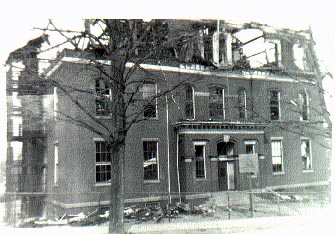
From The Peabody Times, Nov. 17, 1944
Lt. Philip Dorgan Memorial Mass
With full military honors and people from all walks of life in attendance a requiem high memorial mass was celebrated on Saturday morning at nine o'clock at St. John's Church for the late Lt. Philip Dorgan of the United States Marine Air Corps who died suddenly on Nov. 2nd in an airplane crash in the Pacific. The esteem and regard which the community as a whole had for this young man was demonstrated by the large attendance of persons from all phases of the industrial, civil, political and social life of this city.
A platoon of Marines in charge of Lt. James Heard from the Boston Navy Yard and all veterans of Guadalcanal headed the professional march with Commander George D. Morse, Jr. of the North Shore Marine League and Chaplain Harold Bailey of Leominster, Massachusetts of State Marine Corps League bearing the colors of the United States Marine Corps. Peabody Post No. 153 of the American Legion headed by Commander Ralph Lawrence and composed of Michael McCarthy and Francis Buckley as color bearers and Frederick Sherry, Joseph Kierrance, John Trainor, John Daley, and Charles Sheppard as a guard of honor marched in the processional and Commander Ralph Lawrence at the conclusion of the service presented a flag to Lt. Dorgan's mother.
Rev. Thomas A. McDonald of the parish celebrated the mass and Newal Flynn of Danvers, Organist and Mrs. Alice Roche O'Connor of Peabody, Soloist were in the choir. Corp. John P. Woods of U.S. Army and Lt. Thomas Flynn of U.S. Navy served as ushers and escorted the family to their seats. Mrs. Alice Roche O'Connor rendered The United States Marine Corps Hymn at the conclusion of the service and Bugler Charles Mosher of the Marine detail sounded taps.
Arthur Flanagan (1902-1968)
Obituary - Peabody Times, 1/17/1968
Principal Arthur Flanagan, 66
PEABODY - Arthur Flanagan, 55 Gardner St., a member of the Peabody school system since 1925, died at 9:15 a.m. Tuesday (Jan. 16) at Massachusetts General Hospital, Boston, following a short illness.
Flanagan, 66, was graduated from Salem State College and did graduate work at both Boston University and Boston College. He was elected as an eighth grade teacher and vice-principal of Wallis School in October, 1925, and from there became principal of Center School. In December 1948, he was elected principal of Thomas Carroll School and has been there since.
He was a past president of the Peabody Teachers Association, chairman of the salary committee and a member of the superintendent's advisory committee. He was also a former (Peabody Institute) library trustee.
School Supt. J. Henry Higgins said that Flanagan "was one of our dedicated and devoted teachers with a good understanding of youth."
Before the school system had a youth adjustment counselor, Higgins said, troublesome pupils were placed under the guidance of Flanagan.
"The school committee has lost a valued member who was completely dedicated to his task," Higgins said.
Born in Peabody, son of the late Patrick and Anne (Duffy) Flanagan, he lived here all his life.
He coached elementary school basketball and his teams received many honors He also organized the Center School Drum Corps, which participated in many parades in Boston and won many awards.
He leaves his wife, Mrs. Sarah H. (Horgan) Flanagan; one daughter, Miss Jane E. Flanagan, a second grade teacher at the Samuel Brown School; twin sons, John A. and Arthur K. Flanagan, seniors at Peabody High School, and several nieces and nephews.
The funeral will be from the P.M. Cahill & Sons Funeral Home, 20 Church St., Peabody, Friday at 8 a.m. followed by a High Mass of Requiem in St. Thomas the Apostle Church at 9 a.m. Burial will be in St. Mary's Cemetery, Salem.
Visiting hours will be Wednesday, 7 to 9 p.m. and Thursday, 2 to 4 and 7 to 9 p.m.
Letters to the Times, undated, newspaper clipping from his daughter, J. Pattison
Arthur Flanagan was warm, sincere, devoted, patriotic
Editor Peabody Times:
After reading of the passing of Arthur J. Flanagan in your newspaper I thought of how nice it would have been for all of your readers to have known him.
When I first met Arthur at the old Center School I knew he was a man I liked. He was a warm and friendly man who was humble and knew humility. He proved that he was a real American in so many ways, through his participation in civic affairs and his kindness to and interest in the new citizens who came to our land. The drum corps which he organized at Center School was always led by him in all parades and patriotic observances.
As principal, the welfare of his students was his first interest. I can still see him out in the front yard of the school in the morning, watching to see that his boys and girls crossed safely. And he would be out there in the afternoon to see they were safely off to home, regardless of the weather.
Many a fine athlete got his star under the watchful eye and encouragement of Arthur. His basketball teams were always in contention and he gave many hours of his own time without a thought of monetary reward.
He was a fine and devoted father, yet his family and pupils had felt his firm justice. He was devoted to the welfare of his mother until her last days.
I hope that through knowing Arthur, I can guide my own life with some of his human qualities.
I am sure that the beautiful memories that his family has been left by this man who was so enriched with God's blessings will help them soon forget their sorrow.
Stuart Bell
5 Pleasant St.
Peabody
Letter to the Editor, undated, newspaper clipping from his daughter, J. Pattison
Arthur J. Flanagan
Editor, Peabody Times:
I lay in bed this night, feeling so much expression for a dear man that my whole family dearly loves. I say my prayers for his family and wish I could give them some word, or say something to console them for their loss.
My writing this letter will hardly let anyone know or express how we felt about Arthur J. Flanagan.
My children had him as their principal at the Carroll School. I, too, had him for a teacher when I attended Center School. He was not only a teacher, but a dear friend to all who needed a friend.
He was always concerned with every child's problems, especially those children who had so much less than others. He let these children feel special in their own way.
There was so much sincerity in this man, that everyone who had the privilege to know him knew he was a special gift to us. His amusing stories, and his strength when we needed it, there were so many things it would take this whole newspaper to write about him.
It has been quite a while since I've been in school, but I will never forget this man and his kind and thoughtful ways. I will miss him very much, as so many others will. Bless his wife and children, who will be without him.
Bless you, Mr. Flanagan, and bless your dear family. The people upstairs are awfully lucky to have you.
I'm ending this letter feeling heartsick, but at the same time realize it was an honor and a privilege to have been one of your students and to have had my children know you.
Mary MacDougall
10 Mt. Vernon St.
Peabody
Undated, newspaper clipping from his daughter, J. Pattison
Memorial Is Planned For Flanagan
PEABODY - The Carroll School PTA recently received permission from the School Committee to dedicate the gymnasium at Peabody High School to Arthur J. Flanagan, Carroll School principal who died in January.
Mrs. Albert Roy, 18 Tremont St., Peabody, president of the PTA said that they area planning to commission an artist to paint a portrait of Flanagan, who had been principal of the school since 1948.
Since funds are needed for the dedication, Mrs. Ray (sic) has asked for citywide support.
Undated, newspaper clipping from his daughter, J. Pattison
Flanagan Gym Dedicated
City Honors Its Mr. Chips
By Sherrie Somas
PEABODY - The dedication of the High School Gymnasium [on King St. Ext., now the Higgins Middle School] in memory of the late Arthur J. Flanagan Tuesday night was not a dry long-winded eulogy to the former Carroll School principal.
There were tributes with just the right words, there were tears with true sentiment, there were politicians not making politics, there were more than 150 friends of Arthur J. Flanagan giving just homage to the man "who made his friends by being one."
Arthur J. Flanagan died this past January. He had been a teacher in the Peabody School System since the early 1920's and principal of the Carroll School since 1949. His wife and daughter today carry on his tradition teaching in the Farnsworth and Samuel Brown Schools.
Those who knew him spoke of him as a man dedicated to his teachers and his students; they spoke as administrators and pupils.
Rep. Philip J. O'Donnell said of the former principal: "He was Peabody's Mr. Chips."
Those who read Conrad's "Goodbye Mr. Chips" know how high this tribute scaled. And as "Chips" was loved by his students, so was Arthur J. Flanagan as was evident in the unembarrassed tears shed by Suzanne Tarasuk, 14, as she sang "Climb Every Mountain."
Introduced as girl "whose voice delighted Mr. Flanagan," the Kennedy School student gave a melodious compliment to her former principal and quietly hid her tears amidst applause from the audience.
"He was the best principal I ever had," said the teenager, who had been a pupil at the Carroll School for six years. "He understood. He remembered the graduation, Memorial and Christmas Day exercises. He was really a friend and was never too busy to help anybody. All the students felt bad when he passed away."
The [Salem] Evening News, 2/15/1968
Carroll School Gym Will Be Renamed
in Honor of Former Principal
PEABODY - None who knew him will dispute renaming the high school gymnasium in honor of Arthur J. Flanagan, late principal of the Carroll School.
Before the School Committee now is a Carroll School request to rename the gym in honor of the Peabody educator, whose name was synonymous with school athletics in his 42-year tenure in the Peabody school system.
Spearheading the drive the past two months to honor Flanagan, who died Nov. 16, 1967, has been the Carroll School PTA, headed by President Mrs. Albert Roy.
The PTA members are currently soliciting contributions to purchase a portrait plaque of Mr. Flanagan to hang in front of the gym.
As principal of the Center Elementary School some 40 years ago, Flanagan organized the first pre-teen baseball and basketball teams in the city. His Center School teams repeatedly won the intra-city league crowns.
Administrators who co-ordinate high school athletics can appreciate the tribulations of trying to establish a program on the elementary school level. This, however, Flanagan did - and with success as will attest many of his former student athletes.
Flanagan's enthusiasm for children overflowed from the classroom not only in sports, but also into the drum corps for your musicians. Through the 1920s and '30s, his Center School drum corps participated in many parades and won numerous awards.
Flanagan became principal of the Carroll School in 1946. He worked diligently with the non-English speaking students at the Carroll.
Parents respected him as a strict but fair disciplinarian, who always considered the children first. The rapport he achieved with his pupils and their parents has rarely been equaled in the city.
The following tribute to Flanagan was read into the School Committee record Tuesday night by his friend and fellow educator, School Supt. J. Henry Higgins.
The tribute reads:
"Whereas: The services of Arthur J. Flanagan as a teacher and a principal were terminated by his untimely death after forty-two years of faithful and diligent service, and
"Whereas: The many who came under his guidance and jurisdiction have had imparted to them the respect for the virtues of truth, and honesty, as well as the skills of his labors in the field of teaching, and
"Whereas: The example of his devotion to these ideals has imparted to many of our civic leaders, the successful members of our professions, and the upright solid citizens of our community, the true way of life,
"Be it therefore resolved: That the School Committee of the City of Peabody hereby expressed its sincere regret over the loss of his services and offers this written testimonial of a grateful citizenry to a most deserving public servant, and
"Be it further resolved: That these resolution be spread upon the official records of the School Department, and a copy thereof be forwarded to his bereaved family as an humble, yet sincere token of appreciation of a public servant who gave of himself in the cause of education.
"So voted by the School Committee of the City of Peabody this 13th day of February, nineteen hundred and sixty-eight."
NOTE:
The gymnasium at the Thomas Carroll School was not renamed. It was previously named in honor of Elizabeth Quinlan, a long-time teacher at the school. The gymnasium at the Center School was named in honor of Lieut. Philip Dorgan.
The portrait of Flanagan was hung in the gymnasium of the Peabody High School (now the Higgins Middle School). His daughter, Jane Pattison, said that the portrait was later vandalized and removed.
When the Peabody School History Project was documenting the history of the Higgins Middle School, there was no evidence that the gym was dedicated to Flanagan.
Julianne McLaughlin, a Center School teacher who also attended the school as a elementary student, Interview - March 20, 1998
Mr. Flanagan "was at the Carroll Scholl when the Center School burned. I was at the Carroll because we did double sessions at the Carroll and he was principal. I remember because I fell in the yard and he picked me up."
"The high school coaches loved having anybody who played on the Carroll School team because they were wonderful and it didn't matter what nationality they were. Mr. Flanagan incorporated everybody into his teams, no matter what they were. It didn't matter to him, it only mattered that they played."
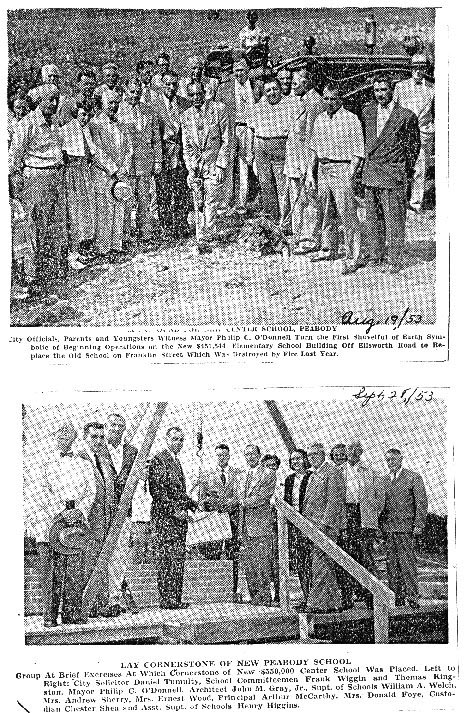
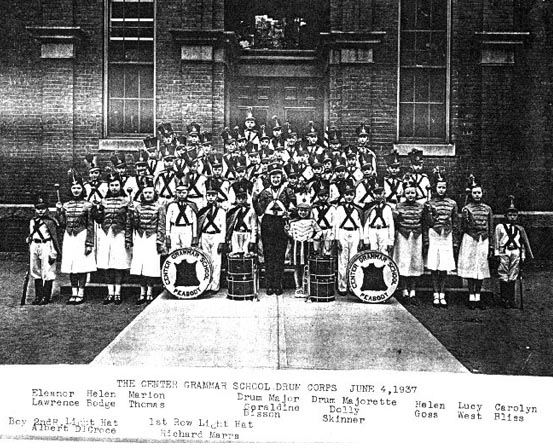
Misc. Photos
